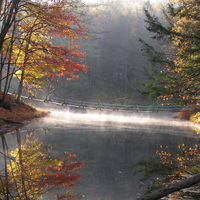Ashokan Center facts for kids
Quick facts for kids |
|
|
Ashokan Field Campus Historic District
|
|

The Wiggly Bridge
|
|
| Lua error in Module:Location_map at line 420: attempt to index field 'wikibase' (a nil value). | |
| Location | Olive Bridge, New York |
|---|---|
| Area | 385 acres (156 ha) |
| Built | 18th century-1967 |
| NRHP reference No. | 100003622 |
| Added to NRHP | 16 April 2019 |
The Ashokan Center is a special place in the Catskill Mountains of New York. It's an outdoor center for learning, meetings, and group getaways. For over 40 years, schools have used Ashokan's natural spaces like forests, waterfalls, and meadows as their classroom.
When schools aren't there, the center hosts music camps, blacksmithing workshops, and other groups. The name Ashokan comes from the Iroquois language. It means "place of many fishes" or "where waters meet."
This beautiful location even inspired a famous song! Jay Ungar wrote "Ashokan Farewell" after visiting. This song later became the main music for the TV show The Civil War. In 2019, the Ashokan Center was added to the National Register of Historic Places.
Ashokan Center's History
The land where the Ashokan Center now stands has a long history. The first European settlers arrived in the 1700s. One family, the Bush family, built homes here.
During the American Revolutionary War, this area was a frontier. Sometimes, people who supported the British would raid homes. One of the Bush family's homes was attacked, and children were taken. This was a big problem, so George Washington even approved building a fort nearby. That fort is now under the waters of the Ashokan Reservoir.
From 1967 to 2008, the property was known as the Ashokan Field Campus. It was run by SUNY New Paltz.
In 2008, the land was sold. Part of it went to the New York City Department of Environmental Protection. The rest went to a non-profit group called the Ashokan Foundation. This foundation still runs the Ashokan Center today. They continue to offer amazing outdoor education programs for schools. They also host music and dance camps, which have been running since 1980. New arts programs are also being developed.
Ashokan's Ancient Geology
The story of Ashokan goes back over 400 million years! That's when the area was formed during a time called the Devonian Period. Much later, during the Ice Age, huge glaciers shaped the land.
The Esopus Creek had to work hard to find its way through the land. It was blocked by piles of rocks and dirt left by the glaciers. Places like Winchell's Falls and Cathedral Gorge are quite new, only about ten thousand years old.
After the glaciers melted, the land was rocky and cold, much like northern Canada today. It was covered in tundra plants. Huge ice age animals like mammoths and Mastodons roamed here. They followed trails along the Esopus Creek. Eventually, the climate warmed, and spruce and fir forests grew. The first people also came to this area, hunting these large animals.

